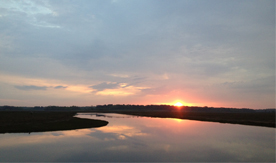
Ten-State Study Focuses on Hurricane Sandy’s Effects on Tidal Marsh Birds, Plants
The effects of Hurricane Sandy’s devastation on plant and bird communities in coastal marshes from Maine to Virginia are the focus of a 10-state study by researchers from the University of Maine, University of Connecticut, University of Delaware and Maine Department of Inland Fisheries and Wildlife.
Information gathered from more than 1,700 sites before and after the October 2012 hurricane will advance researchers’ understanding of how major disturbances affect these populations and what characteristics make a marsh more vulnerable.
The data will also provide information on the allocation of millions of dollars of federal restoration funds, coastal management planning and the status of species at risk of endangerment.
The yearlong study was awarded nearly $200,000 from the National Science Foundation and is part of the Saltmarsh Habitat and Avian Research Program, which was founded by a group of academic, governmental and nonprofit collaborators — including UMaine — to provide tidal-marsh bird conservation information.
Brian Olsen, assistant professor in UMaine’s School of Biology and Ecology, is a co-principal investigator of the study. Maureen Correll, an ecology and environmental Ph.D. student in Olsen’s lab, is working on the project as part of her dissertation. Two additional student researchers from UMaine are expected to participate in the study.
Other co-principal investigators include Tom Hodgman, senior wildlife biologist at the Maine Department of Inland Fisheries and Wildlife; Chris Elphick, associate professor of ecology and evolutionary biology at the University of Connecticut; and Greg Shriver, associate professor in the Department of Entomology and Wildlife Ecology at the University of Delaware.
Before Hurricane Sandy, Olsen’s team was working on a study to assess the distribution and densities of tidal-marsh birds from Maine to Virginia. The study was intended to give the U.S. Fish and Wildlife Service more information on bird populations that are in danger due to the loss of tidal marshes from sea level rise, particularly the saltmarsh sparrow, Olsen says.
Hurricane Sandy struck in the middle of the researchers’ survey range after they had collected data for two years, giving them information from both inside and outside the storm’s path. The team sought NSF funds to conduct the surveys again to see which birds and marshes were most affected within the hurricane’s range. The marshes outside the storm’s path will serve as control sites, Olsen says.
“What predicts whether you’re a winner or a loser if a hurricane hits you is really an open question,” Olsen says.
The study will also test two common ecosystem stress hypotheses among researchers. One of those hypotheses, Olsen says, is that stresses on an ecosystem build up over time, making the addition of any new stress more dramatic than if it were to act alone. Multiple stresses can bring any species of the entire community closer to collapse with every additional stress.
“The hurricane ends up being the straw that broke the camel’s back,” he says.
Another common theory says multiple stresses eliminate the weak players, leaving only the strong ones.
“When the hurricane comes in, all the sensitive players have already been eliminated by previous stressors and you’re only left with the ones that are robust to stress; they can handle it, and the hurricane has little effect,” Olsen says.
Based on this theory, the pristine tidal marshes — ones that have more sensitive plants and animals that aren’t accustomed to stress — may appear to have been more affected by the hurricane, he says.
“I’d really like to understand what makes marshes sensitive to large-scale disturbances and how marshes are likely to respond to the predicted increase in storm frequency and intensity in the future,” Olsen says. “What makes them sensitive and what’s likely to happen as the climate changes?”
Researchers will also pay attention to whether urban development had any effect on how the storm affected the marshes.
“You get the same hurricane that’s barreling down on two different marshes. Do marshes that are completely developed right up to the marsh edge fare better, worse or the same as those that are in pristine habitats in national parks? Does conservation do anything to birds that are still around or does that not matter when there’s a wall of water coming down on you? We get to ask that for a fleet of different species,” Olsen says.
Saltmarsh sparrows, clapper rails, Nelson’s sparrows, seaside sparrows, willets and black ducks are the six major bird species in the study. Plant species the team will study include smooth cordgrass (Spartina alterniflora), salt hay (Spartina patens), seashore saltgrass (Distichlis spicata) and black needlerush (Juncus gerardii).
The surveying of saltmarsh sparrows is important because the team is able to track the species’ entire range and population. The species is also declining fast and talks have begun on whether to list them under the Endangered Species Act. The team’s data on the birds will be used to help make that determination, Olsen says.
Using the information from hundreds of marshes with different characteristics, Olsen’s team hopes to be able to predict what causes ecosystems to shift from one type of tidal marsh to another following a major storm, or more dramatically, what causes shifts from tidal marsh to open water or beach dunes. By determining these factors, researchers will have a better understanding of where to focus energy for conservation and where to expect ecosystem shifts in the future, Olsen says.
“We’ve visited a couple places already this summer where last year it was a beautiful tidal marsh with picturesque streams, and now it’s sand dunes or open water; it’s just gone,” he says.
The team hopes their information will help influence agencies using Hurricane Sandy relief funds to restore wildlife communities by prioritizing the marshes that would benefit the most from conservation efforts and have the lowest chance of being destroyed by a similar storm in the future.
Contact: Elyse Kahl, 207.581.3747
